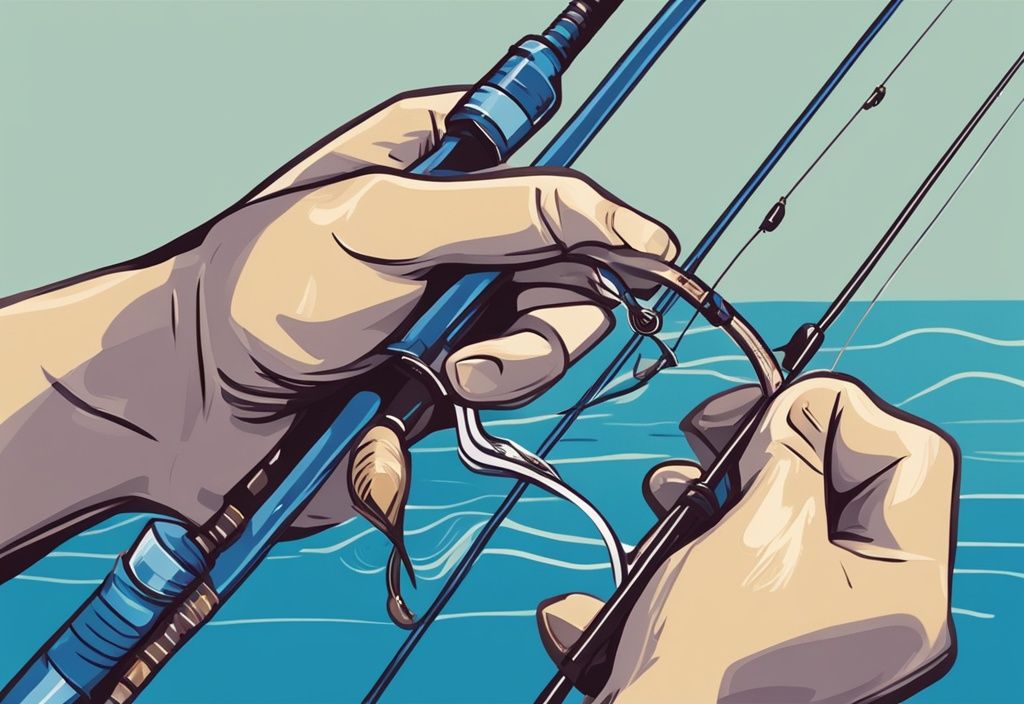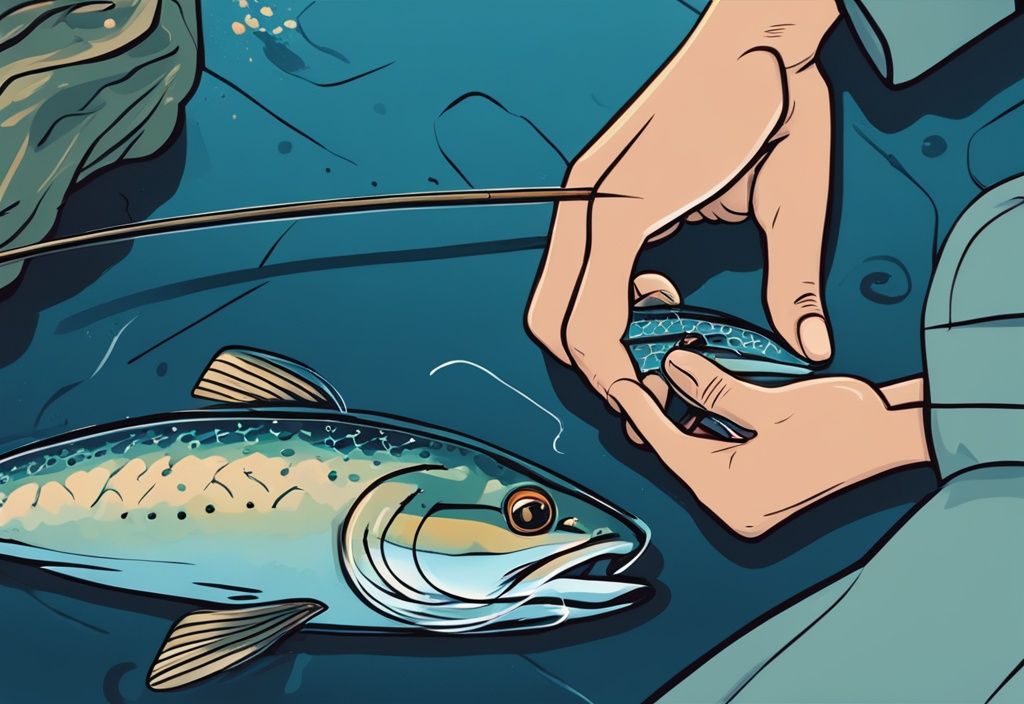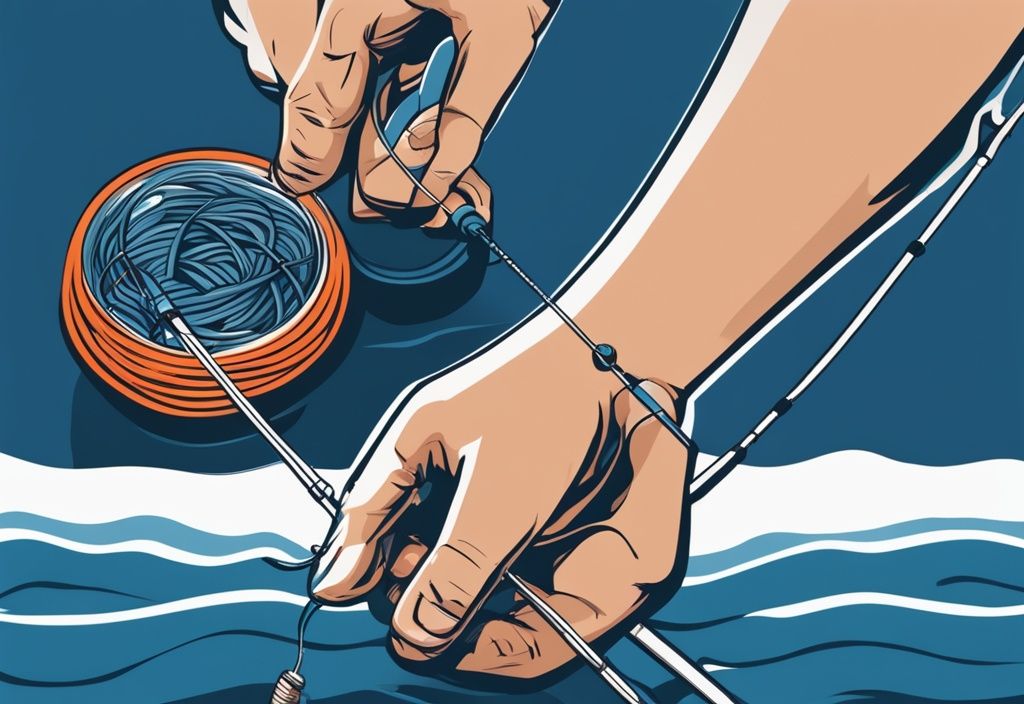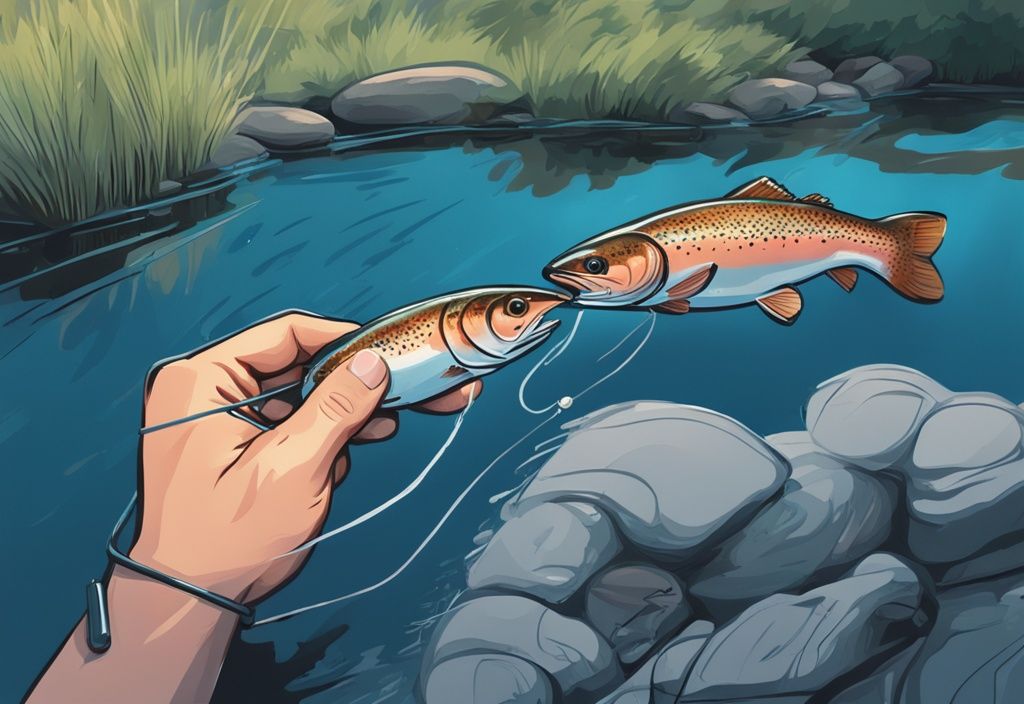Ever wonder why trout always manages to slip away from you? Trout, being the notorious finicky feeders they are, demand an accurate fishing line setup to get caught. Join me, Jake Marlin, as I teach you the ins and outs of setting up your fishing line for trout – a task that holds the secret key to your angling victory.
From choosing the perfect rod and line for the job, to the tricks of the trade in knot tying – I’ve got you covered. Sprinkled with tales from my two decades of adventures, this expert guide will not only teach but also entertain, keeping your spirits high while mastering the techniques.
So, ready to turn those elusive trout encounters into triumphant catches? Let’s dive in and embark on this exciting trout fishing journey together. Your improved angling success starts here.
Identifying Your Trout Fishing Needs
Importance of Choosing the Right Fishing Line for Trout
Hey there, fellow anglers! Ever wonder how to set up fishing line for trout to maximize your catch? Well, let me tell you, it’s an essential skill for any trout fisher. Picture this: you’re out by the stream, the sun just starting to peek over the horizon, and there’s a subtle ripple in the water—a perfect trout habitat.
Now, trout are notoriously picky eaters, so using a 4 to 8 lbs clear monofilament or fluorocarbon line could be your secret weapon. This line is almost invisible underwater, making it a great choice to fool those sharp-eyed trout. Not only does this help present your bait in the most natural way, but it also allows for a more accurate cast.
By opting for the right line, you’ll enhance your sensitivity to the faintest nibbles and bites. Trust me, feeling that slight tug is one of the most thrilling parts of fishing. It’s like having a sixth sense! And more precise detection? That’s going to lead you straight to more catches and an overall fantastic fishing journey.
Types of Trout and Their Preferred Habitats
Understanding the different types of trout and where they like to hang out can seriously improve your fishing game. Most trout love clear, cold waters, whether it’s a fast-moving stream or a peaceful lake. These places, with their rich oxygen levels, are ideal playgrounds for trout—think of them as the luxury resorts of the fish world.
Take note of the seasons and their habits. For example, in warmer months, you’ll often find trout chilling in the deeper pools of streams to keep cool. Knowing these patterns is like having a treasure map. It guides you on where to cast your line and how to set it up perfectly to mimic the trout’s natural feeding scenario.
So, next time you’re gearing up, remember: the right line setup isn’t just about catching fish; it’s about connecting with the natural rhythms of these remarkable creatures.
Happy fishing, and may your lines always be tight!
Assembling Your Trout Fishing Gear
When it comes to setting up your fishing line for trout, having the right gear is paramount. Let’s dive into the key components:
Choosing the Best Fishing Rod and Reel for Trout
When you’re figuring out how to set up fishing line for trout, your journey starts with picking the ideal fishing rod. Trust me, a lightweight rod between 6 to 8 feet works wonders. The length gives you that perfect balance of casting distance and pinpoint control, both of which are vital for tricking those cunning trout. Plus, it makes those subtle nibbles and quick flicks of the fish much easier to manage.
Next up, let’s talk reels. For trout fishing, spinning reels are the way to go. They’re easy to use—even for beginners—and incredibly accurate. Before you head out for a fishing trip, make sure you know how to obtain a fishing license in Montana. Their aptitude for handling lighter lines makes them particularly suitable for this type of fishing. You’ll appreciate the smooth casting and retrieval action they offer, making the entire experience more enjoyable. Spinning reels are not just beginner-friendly; they’re a versatile addition to any angler’s toolkit.
Selecting the Perfect Line: Monofilament vs. Fluorocarbon
Another critical piece of the puzzle in how to set up fishing line for trout is picking the right fishing line. The age-old debate between monofilament and fluorocarbon lines often leaves many anglers scratching their heads, so here’s the lowdown:
- Monofilament: This line is a fan favorite, especially for those just starting out. Its elasticity provides a cushioning effect against sudden pulls, making it a forgiving choice when you’re reeling in a lively trout. Besides, monofilament is easier on the pocket and simpler to handle—no rocket science required here!
- Fluorocarbon: Now, for the more seasoned angler, fluorocarbon is where it’s at. Its density renders it almost invisible underwater, a huge advantage when fishing in clear rivers where trout are particularly skittish. It sinks faster and has better abrasion resistance, offering durability around rocky terrains. The heightened sensitivity also means you’ll feel even the slightest nibble, boosting your chances of a successful hook set.
Consider your fishing conditions and personal preferences when choosing between these two types of line. Making an informed choice here is a significant step towards mastering how to set up fishing line for trout. The right line can make all the difference in your fishing success, turning a day on the water into an unforgettable adventure.

Preparing Your Fishing Line for Trout
When setting up your fishing line for trout, attention to detail can make all the difference. Understanding the right line strength and length, mastering the spooling process, and ensuring your line stays tangle-free are essential steps. Let’s break it down.
Determining the Appropriate Line Strength and Length
To effectively set up your fishing line for trout, choosing the right line strength is pivotal. For your trout fishing adventures, a line strength of 5-10 lbs is usually spot-on. This range strikes a perfect balance—strong enough to handle a hefty trout, yet sensitive enough to detect those subtle nibbles. You’ll also want your line length to be in the 4 to 6 feet range. This length ensures plenty of distance between your bait and hook, making your lure presentation irresistibly natural to the skittish trout.
Essential Steps to Spool the Fishing Line on the Reel
Getting your fishing line spooled correctly is a game changer for a successful trout fishing trip. Start with a trusty arbor knot to secure your line to the reel spool—this knot keeps things nice and tight, so your line doesn’t slip when you start reeling in. As you spool the line, keep consistent tension to prevent slack, which can lead to some nasty tangles down the line. Make sure to spool the line evenly across the spool; it’s like laying a smooth road for your line to travel. Nail these steps, and your trout fishing setup will be flawless.
How to Ensure Your Line is Tangle-Free
Nothing puts a damper on a fishing trip faster than a tangled line. To keep things smooth and tangle-free, a line conditioner can be your best friend. This nifty product helps reduce line memory, preventing those annoying coils and tangles. Another pro tip is to regularly inspect your line for twists and tangles as you spool it. This little check can save you loads of hassle out on the water. Don’t forget to use swivels with your lures—they’re fantastic at cutting down line twists. Stick to these steps, and you’ll keep your fishing line hassle-free, ensuring a more enjoyable day on the water.
Mastering Knot Tying Techniques for Trout Fishing
Secure and Effective: The Improved Clinch Knot
Understanding how to properly tie knots is crucial when learning how to set up fishing line for trout. There’s something almost meditative about the process, and the Improved Clinch Knot is a trusted companion in this journey. This knot has earned its stripes among anglers for its strength and reliability.
Begin by threading the fishing line through the eye of the hook. Next, wrap the end of the line around the standing part 5-7 times, creating friction and adding strength. After wrapping, pass the tag end through the small loop by the hook’s eye, and then again through the larger loop formed by this action. Moisten the knot slightly before pulling tight to ensure it tightens effectively and doesn’t slip. This final step reduces friction, firmly securing your hook in place.
The Versatile Palomar Knot and When to Use It
When setting up fishing line for trout, the versatility of the Palomar Knot is your secret weapon. Anglers love this knot for its simplicity and exceptional strength.
Start by doubling about 6 inches of the fishing line and passing this loop through the eye of the hook. Then, with the doubled line, tie a basic overhand knot, ensuring the hook stays within the loop of this knot. Following this, pass the hook through the loop before tightening. It’s crucial to pull both ends – the standing line and the tag end – simultaneously to ensure a snug and secure knot. This knot is especially beneficial when using braided lines, providing consistency and reliability to your trout fishing setup.
Whether you’re knee-deep in a babbling brook or casting from the shore, mastering these knots will undoubtedly enhance your fishing experience. So, next time you’re preparing your fishing gear, take a moment to appreciate the art of knot tying – it’s a skill that, once perfected, connects you even more deeply to the timeless pursuit of trout fishing.
Rigs and Baiting Techniques for Successful Trout Fishing
When it comes to setting up your fishing line for trout, having the right rig and baiting techniques can make the difference between a slow day and a bountiful catch. Understanding various setups and how to implement them effectively will ensure you’re ready for any trout fishing scenario. Let’s dive into three essential rigging techniques that will help you reel in those elusive trout.
Introduction to Various Trout Rig Setups
Float (Bobber) Fishing Rig: Components, Setup, and Use
Ever tried float fishing? It’s a fantastic way to catch trout, especially when they’re hanging out in the middle or near the surface. To set up a float (bobber) fishing rig, you’ll need a few key components: a bobber, hook, weight, and some bait.
Start by sliding a bobber stop onto your fishing line, then add the bobber itself. Next, tie a swivel to your main line. Attach a 12-18″ leader line to the swivel—it’s this leader that connects to your hook. This rig is particularly effective because the bobber acts as a visual bite indicator, giving you a clear sign when a trout nibbles.
Bottom Fishing Rig: Components, Setup, and Use
If trout are feeding close to the bottom, a bottom fishing rig is your go-to setup. Here’s what you’ll need: a slip sinker, swivel, leader line, and a hook with bait.
Begin by threading the slip sinker onto your main line. After that, attach a swivel to stop the sinker from sliding too far. Tie a 12-18″ leader line to the swivel, ending with your baited hook. This rig is excellent for keeping your bait stable and ensuring it gets to the depth where trout are lurking.
Lure Fishing Rig: Components, Setup, and Use
In the mood for some active fishing? Lure fishing is perfect for covering more water and locating trout. Essential components here include a clip swivel and a lure.

To set it up, tie a clip swivel to your main line. This reduces line twists and makes lure changes a breeze. Attach your lure to the clip swivel, then you’re ready to cast. This rig is ideal for moving around and attracting trout with the lure’s action.
Selecting the Best Baits and How to Hook Them Properly
Picking the right bait is paramount, and so is hooking it properly. Common favorites for trout include nightcrawlers, minnows, salmon eggs, and a host of artificial options like soft plastics or trout jigs.
When baiting your hook, it’s crucial to thread the bait along the hook’s shape, ensuring it covers the hook entirely. This way, the trout can’t easily swipe your bait without getting hooked. Proper bait presentation is the name of the game—entice those finicky trout and make sure they stay hooked once they bite.
Casting Your Line: Techniques Every Trout Angler Should Know
Casting your line with precision and ease is crucial for a successful trout fishing experience. Whether you’re navigating tight spaces or dealing with obstructions, mastering various casting techniques will enhance your ability to set up your fishing line for trout. Let’s dive into some essential methods.
Overhead Cast: Comprehensive Guide
To master the overhead cast, start by positioning yourself with the rod held firmly using both hands and the reel facing down. This grip ensures control and stability. Lift the rod tip smoothly over your shoulder, forming a backswing that positions the line properly.
Then, with a forward sweep of the rod in a fluid motion, release the line at approximately the 1 o’clock position. Timing is key here; get it right, and you’ll achieve optimal casting distance and accuracy. Trust me, when done correctly, this technique enhances your ability to place the bait where trout are likely to bite, ensuring success in your fishing endeavors.
Side Cast: Step by Step Instructions
The side cast is particularly useful in situations where overhead obstacles might hinder your cast. Begin by holding the rod parallel to the ground, ensuring the reel faces up for better control. With a steady motion, swing the rod to the side.
The release point is crucial; let the line go when the rod is at a 90-degree angle relative to the ground. This method provides a lower trajectory, making it easier to navigate under trees or other obstructions. Perfecting this cast will broaden your versatility in various fishing environments, helping you learn how to set up fishing line for trout in diverse scenarios.
Roll Cast: Tips and Tricks
The roll cast is an essential technique for tight quarters where a backcast isn’t possible. Start with the rod tip low, near the water. Slowly lift the rod tip, forming a D-loop behind you — this loop is critical for loading the rod.
Then, push the rod forward with authority, allowing the inertia to straighten the rod tip and launch the line forward. Release the line at the right moment to maximize your casting distance. This technique is often used in streams or shallow waters where maneuverability is restricted, enhancing your ability to effectively set up fishing line for trout in confined areas.
Conclusion: Recap on Setting Up Fishing Line for Trout
-
Review the importance of choosing the right line, rod, and reel for trout fishing.
Selecting the right gear is like setting the stage for a thrilling fishing adventure. Imagine the subtle tug on a 4 to 8 lbs clear monofilament or fluorocarbon line that whispers a trout’s presence. Pair that with a lightweight, 6-8ft fishing rod, giving you nimble control at every turn. And let’s not forget the spinning reel’s harmonious simplicity and precision, making every cast feel like a well-rehearsed song. -
Recap the steps for spooling and preparing your line.
Proper spooling is your line’s lifeline, preventing the frustrating snarl of a tangled mess. Begin by binding your line to the reel spool with a trusty arbor knot. Keep an even tension, ensuring the line lays evenly as you spool. Make a habit of checking for twists and applying line conditioner to keep it in peak condition, akin to tuning an instrument before a performance. -
Emphasize essential knot-tying techniques and rig setups.
Tying secure knots is an art every angler must master. Picture the Improved Clinch Knot and Palomar Knot as your faithful companions; the Clinch Knot, steadfast and strong, and the Palomar, reliable and easy-going. Each serves its purpose. Meanwhile, consider effective rig setups like Float (Bobber), Bottom Fishing, and Lure Fishing rigs. Each method is tailored for specific water conditions and trout behaviors, much like selecting the perfect lure to match the hatch. -
Highlight effective casting techniques for successful trout fishing.
Perfecting your cast is like learning dance steps. The Overhead Cast is your go-to for long-distance grace, the Side Cast helps you navigate around low-hanging obstacles, and the Roll Cast is your ace in tight quarters. Each technique boosts your ability to present the bait just where those cunning trout lie in wait, ever ready to surprise and thrill.

By focusing on these crucial aspects, you’ll be well-equipped to set up your fishing line for trout, ensuring a successful and enjoyable fishing experience.
FAQ for Setting Up a Fishing Line for Trout
What Type of Fishing Line is Best for Trout Fishing?
Choosing the right line is crucial. I’d recommend a 4 to 8 lbs clear monofilament or fluorocarbon line. These types blend seamlessly into the water, enhancing bait presentation and making them practically invisible to those clever trout.
How Long Should a Fishing Line Be for Trout Fishing?
In my experience, a fishing line should be about 4-6 feet long. This length gives your bait the perfect distance from the hook, increasing the chances of enticing those beautiful trout. Ever found yourself wondering if your line is too short or too long? This range usually hits the sweet spot.
What Are the Most Effective Baits for Trout Fishing?
Over the years, I’ve tried a gamut of baits. Nightcrawlers, minnows, and salmon eggs often hit the mark. But don’t overlook artificial baits like soft plastics or trout jigs – they can be game-changers, especially when you want to mix things up. Every cast has its own adventure, doesn’t it?
How Do You Tie a Secure Knot for Trout Fishing?
The magic often lies in a well-tied knot. I’d suggest mastering the Improved Clinch knot and Palomar knot. They’re reliable choices and have saved more fishing trips than I can count. Ever felt the frustration of losing a fish because of a bad knot? These knots will keep those heartaches at bay.
What Are the Different Rig Setups for Trout Fishing?
Ah, the diverse world of rig setups. Each has its own charm and utility:
- Float (Bobber) Fishing Rig: Suspends bait at mid-water levels or near the surface. Perfect for those lazy, sunny afternoons when trout swim higher.
- Bottom Fishing Rig: Positions bait near the bottom, ideal for deeper waters where the bigger, wiser trout linger.
- Lure Fishing Rig: Uses artificial lures to cover more area. Great for casting and retrieving, keeping you active and moving.
Each rig tells its own story and offers a unique way to connect with the environment and your catch. Ever tried switching rigs mid-trip? The results can be surprising!


